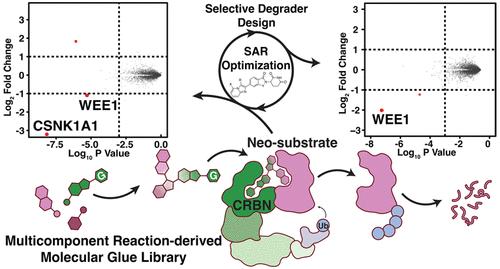Discovery of CRBN-Dependent WEE1 Molecular Glue Degraders from a Multicomponent Combinatorial Library
IF 14.4
1区 化学
Q1 CHEMISTRY, MULTIDISCIPLINARY
引用次数: 0
Abstract
Small molecules promoting protein–protein interactions produce a range of therapeutic outcomes. Molecular glue degraders exemplify this concept due to their compact drug-like structures and ability to engage targets without reliance on existing cognate ligands. While cereblon molecular glue degraders containing glutarimide scaffolds have been approved for treatment of multiple myeloma and acute myeloid leukemia, the design of new therapeutically relevant monovalent degraders remains challenging. We report here an approach to glutarimide-containing molecular glue synthesis using multicomponent reactions as a central modular core-forming step. Screening the resulting library identified HRZ-1 derivatives that target casein kinase 1 α (CK1α) and Wee-like protein kinase (WEE1). Further medicinal chemistry efforts led to identification of selective monovalent WEE1 degraders that provide a potential starting point for the eventual development of a selective chemical degrader probe. The structure of the hit WEE1 degrader complex with CRBN–DDB1 and WEE1 provides a model of the protein–protein interface and ideas to rationalize the observed kinase selectivity. Our findings suggest that modular synthetic routes combined with in-depth structural characterization give access to selective molecular glue degraders and expansion of the CRBN-degradable proteome.

从多组分组合库中发现依赖 CRBN 的 WEE1 分子胶降解剂
促进蛋白质-蛋白质相互作用的小分子可产生一系列治疗效果。分子胶降解剂因其紧凑的类药物结构和无需依赖现有同源配体就能与靶点相互作用的能力而体现了这一概念。虽然含有戊二酰亚胺支架的脑隆分子胶降解剂已被批准用于治疗多发性骨髓瘤和急性髓性白血病,但设计新的治疗相关的单价降解剂仍具有挑战性。我们在此报告一种利用多组分反应作为核心模块化核心形成步骤的含戊二酰亚胺分子胶合成方法。通过筛选所得到的库,我们发现了针对酪蛋白激酶 1 α(CK1α)和类Wee蛋白激酶(WEE1)的HRZ-1衍生物。通过进一步的药物化学研究,鉴定出了选择性单价 WEE1 降解剂,为最终开发选择性化学降解剂探针提供了一个潜在的起点。命中的 WEE1 降解剂与 CRBN-DDB1 和 WEE1 的复合物结构提供了一个蛋白-蛋白界面模型,并为合理解释观察到的激酶选择性提供了思路。我们的研究结果表明,模块化合成路线与深入的结构表征相结合,可以获得选择性分子胶降解剂并扩展 CRBN 可降解蛋白质组。
本文章由计算机程序翻译,如有差异,请以英文原文为准。
求助全文
约1分钟内获得全文
求助全文
来源期刊
CiteScore
24.40
自引率
6.00%
发文量
2398
审稿时长
1.6 months
期刊介绍:
The flagship journal of the American Chemical Society, known as the Journal of the American Chemical Society (JACS), has been a prestigious publication since its establishment in 1879. It holds a preeminent position in the field of chemistry and related interdisciplinary sciences. JACS is committed to disseminating cutting-edge research papers, covering a wide range of topics, and encompasses approximately 19,000 pages of Articles, Communications, and Perspectives annually. With a weekly publication frequency, JACS plays a vital role in advancing the field of chemistry by providing essential research.

 求助内容:
求助内容: 应助结果提醒方式:
应助结果提醒方式:


